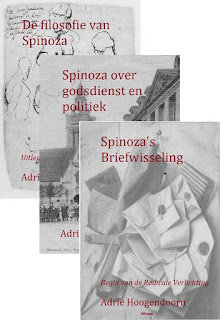Spinoza en hen kai pan - Spinoza’s filosofie is incompatibel met de Anima Mundi-(Wereldziel-)theorie
Ik heb het altijd merkwaardig gevonden hoe makkelijk – zoals Jacobi het voorstelde - Lessings Ἓν καὶ Πᾶν, Een en Alles, aanvaard werd als uiting van zijn ‘Spinozisme’ en aldus Spinoza als aanhanger van de aloude “Al-eenheid”-theorie, als filosofie over de eenheid van alle zijn, inclusief alle verscheidenheid; anders gezegd dus: eenheid van alles. Dat alleen op zich genomen typeert redelijk zijn een-substantie-leer, maar er is het risico dat allerlei vroegere connotaties meekomen die niet des Spinoza’s zijn.
Ἓν καὶ Πᾶν heeft heel oude papieren: gaat terug op Heraclitus “uit alles een, uit een alles.” Toshimasa Yasukata heeft in “Lessing's Philosophy of Religion and the German Enlightenment”* laten zien dat Lessing drie verschillende Griekse formules hanteerde: in een eigenhandig geschreven notitie uit 1780 staat hen ego kai panta; vervolgens zoals Alexander Altmann en Erwin Quapp recent aantoonden, hen ego kai pan [Ik ben Een en Alles]. De derde formule, afkomstig van Jacobi’s rapportage, hen kai pan, duidt niet op een Spinozistisch pantheïsme maar op een panentheïsme van een meer spiritualistische aard. Het is riskant dit nog als Spinozisme te zien (het is het vertrekpunt voor Herman De Dijn om er Spinoza’s systeem als transcendent mee te typeren). Volgens Yasukata moet op filosofische en linguïstische gronden hen ego kai panta Lessing’s meest authentieke formule geweest zijn die suggereert dat de wereld (panta) en God (theos) bemiddeld worden door de eerste persoon “Ik” (ego). Op grond hiervan zou Lessings zienswijze het best getypeerd kunnen worden als “pantaentheïsme”.
Het risico van hen kai pan met Spinoza – die die term nooit gebruikte - in verbinding brengen is hem zo te koppelen aan het hermetisme van Hermes Trismegistos aangevuld met kabbalisme en de idee van de ‘Wereldziel’, zoals het vooral door Giordano Bruno was verspreid, waarvoor de Duitse vroeg-romantici grote belangstelling hadden.
Met vreugde ontdekte ik dat hierover recent een uitvoerig boek is verschenen van de Hongaar Miklós Vassányi die dit uitgebreid uiteenrafelt en laat zien dat Spinoza’s filosofie incompatibel is met de Anima Mundi-(Wereldziel-)theorie (jammer genoeg wel weer ‘n flink prijzig boek)
 Miklós Vassányi, Anima Mundi. The Rise of the World Soul Theory in Modern German Philosophy. Springer, 2011, ISBN 978-90-481-8795-9
Miklós Vassányi, Anima Mundi. The Rise of the World Soul Theory in Modern German Philosophy. Springer, 2011, ISBN 978-90-481-8795-9
[books.google geeft ruim 80 hits op Spinoza]
Het 7e hoofdstuk wordt aldus samengevat: "As we have just mentioned, Spinozism, i.e., BaruchSpinoza’s (1632–1676) system, or, more specifically, its psychological facet – his theory of the mind – has been considered by many as philosophically closely related to the theory of the world soul. The ground for establishing this alleged link has been what is termed by S.Zac as Spinoza’s animism the idea that ‘everything is animate to some specific degree’, “…omnia, quamvis diversis gradibus, animata tamen sunt”. If human mind, mens humana is “nothing else than the idea of an individual thing actually existing” (i.e., if mind is a kind of idea in that it is knowledge of the body correlated to it), and if, analogically, the divine mind is also one universal idea, then God, one of whose essential attributes is the material universe (the world ofextensio) for Spinoza, could be regarded as a mind correlated with that universe, i.e., as a sort of higher anima mundi.” [Hier]
Table of contents
I: Opposition to the identification of the World Soul with God in the philosophia Leibnitio-Wolffiana: The theory of God as the "ens extramundanum." 1. Presentation of the texts relevant for the concept of an "anima mundi." The immediate natural theological setting of the problem. 2. The distinctive philosophical content of the concept of an "anima mundi" in Leibniz and his followers. Arguments of this school against the theory of anima mundi. A broader natural philosophical and metaphysical discussion of their answer positions.
II: "Les naturalistes" – XVIIIth-century physico-theology : The scientific demonstration of the existence and attributes of God from the teleology of nature. The World Soul theory in physico-theology. Physico-theology as a source of inspiration for the Romantics. 1. Preliminary historical and conceptual presentation of "l’histoire naturelle" in selected major works of some leading naturalists. The relation of natural science to theology or spirituality in their works. 2. General philosophical analysis of physico-theology.III. Gradual rise of the concept of a World Soul in the ‘Lessingszeit’. Philosophical Cabbala, Spinozism and mysticism : Böhme & Ötinger; Spinoza, Lessing, & the Pantheismus-Streit; Giordano Bruno’s influence in the epoch. 1. Böhme’s speculative theology (De signatura rerum, 1622). Ötinger’s Cabbalistic theory of the world as a glorious divine epiphany or shekhina & his problematic rejection of the concept of Weltseele (Offentliches Denckmahl der Lehr-tafel einer … Prinzessin Antonia, 1763). 2. The philosophical incompatibility of Spinoza’s system with the World Soul theory. Bayle’s identification of Spinozism with the World Soul theory, and Wachter’s denial of the same. Lessing’s statement concerning the World Soul, and his alleged Spinozism in Jacobi’s Ueber die Lehre des Spinoza… (1785), Mendelssohn’s Morgenstunden… (1785), and Herder’s Gott. Einige Gespräche (1787). Herder’s rejection of the identification of God with the Weltseele. 3. The World Soul in Giordano Bruno’s De la causa, principio et uno (1584) and De l’infinito, universo e mondi (1584). The revival of Bruno’s philosophy in late XVIIIth-early XIXth century German thought. IV. The philosophical postulation of the World Soul in German Romanticism. Baader and Schelling.
_____________
*) Asko Nivala, "Friedrich Schlegel's early Romantic notion of religion in relation to two presuppositions of the Enlightenment" in: Approaching Religion • Vol. 1, No. 2 December 2011 [hier]

